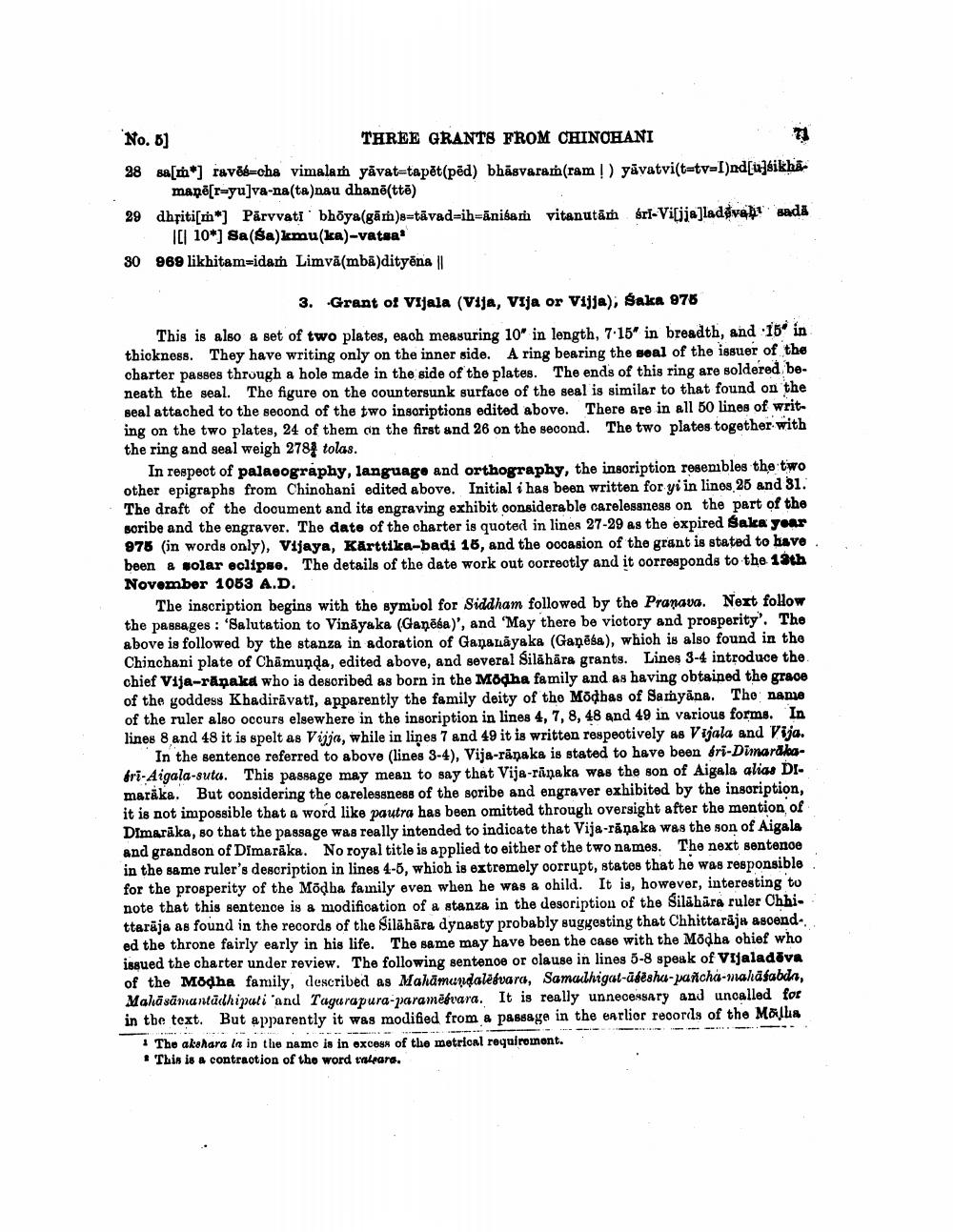________________
No. 6)
THREE GRANTS FROM CHINCHANI 28 sa[m] ravēs=cha vimalan yāvat=tapēt(pēd) bhāsvaram(ram!) yavatvi(t-tv-I)nd[usikhân
maņēsr-yu]va-nasta nau dhanē(ttē) 29 dhpiti[m*] Pārvvati bhöya(gām )s=tāvad=ih=ānisam vitanutām sri-Vi[jja]lad$vabi sada
1[] 10*] Sa(a)kmu(ka)-vatsa! 30 969 likhitam-idam Limvā(mbā)dityéns |
3. Grant of Vijala (Vija, Vija or Vijja), Saka 978 This is also a set of two plates, each measuring 10" in length, 7.15" in breadth, and 15' in thickness. They have writing only on the inner side. A ring bearing the goal of the issuer of the charter passes through a hole made in the side of the plates. The ends of this ring are soldered beneath the seal. The figure on the countersunk surface of the seal is similar to that found on the seal attached to the second of the two insoriptions edited above. There are in all 50 lines of writing on the two plates, 24 of them on the first and 26 on the second. The two plates together with the ring and seal weigh 2784 tolas.
In respect of palaeography, language and orthography, the insoription resembles the two other epigraphs from Chinohani edited above. Initial i has been written for yi in linos 25 and 31. The draft of the document and its engraving exhibit considerable carelessness on the part of the soribe and the engraver. The date of the charter is quoted in lines 27-29 as the expired Sala year 978 (in words only), Vijaya, Kārttika-badi 16, and the occasion of the grant is stated to have been & solar eclipse. The details of the date work out oorreotly and it corresponds to the 19th November 1083 A.D.
The inscription begins with the symbol for Siddham followed by the Pranava. Next follow the passages : 'Salutation to Vināyaka (Ganēta)', and 'May there be victory and prosperity'. The above is followed by the stanza in adoration of Gananayaka (Ganesa), whioh is also found in the Chinchani plate of Chāmunda, edited above, and several Silähära grants. Lines 3-4 introduce the chief Vija-rāņaka who is described as born in the Modha family and as having obtained the grace of the goddess Khadirāvati, apparently the family deity of the Mödbas of Samyāna. The nanje of the ruler also occurs elsewhere in the insoription in linea 4, 7, 8, 48 and 49 in various forms. In lines 8 and 48 it is spelt as Vijja, while in lines 7 and 49 it is written respeotively as Vijala and Vija.
In the sentence referred to above (lines 3-4), Vija-ränaka is stated to have been dri-Dimardkafri-Aigala-suta. This passage may mean to say that Vija-ranaka was the son of Aigala alias DImaraka. But considering the carelessness of the spribe and engraver exhibited by the inscription, it is not impossible that a word like pautra has been omitted through oversight after the mention of Dimarāka, so that the passage was really intended to indicate that Vija-ranaka was the son of Aigala and grandson of Dimarāka. No royal title is applied to either of the two names. The next sentence in the same ruler's description in lines 4-5, which is extremely corrupt, states that he was responsible for the prosperity of the Mödba family even when he was a child. It is, however, interesting to note that this sentence is a modification of a stanza in the desoription of the Silahāra ruler Ohhi. ttarāja as found in the records of the Silähāra dynasty probably suggesting that Chhittarāju asoend.. ed the throne fairly early in his life. The same may have been the case with the Mödba ohief who issued the charter under review. The following sentence or clause in lines 5-8 speak of Vijaladova of the Modha family, described as Mahamandalesvara, Samaulhigal-ūdèshu-pancha-mahasabda, Mahāsāmantadhipati and Tagarapura-paramēgvara. It is really unnecessary and uncalled for in the text. But apparently it was modified from a passage in the earlier reoords of the Malla
The akshara la in the name is in excess of the metrical requiroznont. This is a contraction of the word lears.




